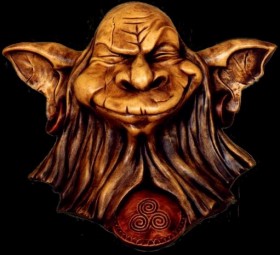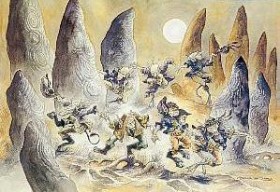Spooky French Folklore Simmers in October
The start of autumn brings longer nights, shorter days, and the anticipated holiday season. This is a time when people cozy up next to the hearth with a hot beverage in hand as the chilly weather settles in for the season. The sweaters and gloves are taken out of hibernation, while those light fun summer […]
The start of autumn brings longer nights, shorter days, and the anticipated holiday season. This is a time when people cozy up next to the hearth with a hot beverage in hand as the chilly weather settles in for the season. The sweaters and gloves are taken out of hibernation, while those light fun summer pieces are stored away, sometimes begrudgingly. Our environment, however, doesn’t just change into pretty fall colored leaves; there lies beneath it all a sinister force that pulls at our minds whenever we encounter a dark corner or turn. Those once-voluptuous branches lose their leaves and transform into strange unaccountable noises during those long, cold nights. Shadows are no longer brushed off as mere tricks of the sun, rather they become forces that haunt our minds.

In France, there are not as many superstitions as can be found in some other countries, but nevertheless the French do have their small share of malevolent legends that start resurfacing in October. The most common of these folklores are based on old Celtic mythology, whereas the others are based on real testimonies.
In the French region of Brittany, the medieval Celtic legend of the Korrigans is one that still thrives. In some cultures they are referred to as goblins, leprechauns, gnomes, imps, or simply evil spirits. They are magical, strong, rich, stingy, and depending on the situation, can be very humorous, generous, or malicious. According to Breton legend, these small, ugly creatures hold rituals in which they dance around a campfire near to one of their underground dwellings. During the night the Korrigans call forth sleeping mortals, leading them to their campfire. The mortals stand in a circle watching as the creatures dance around the fire. This ritual allows the Korrigans to increase a number of their powers. In the case that a mortal should step out of the circle and join the dancing creatures, they will be led into a trap where they will be either killed or sent to an underground cavern with no opportunity to escape.
These mischievous little creatures do not stop at luring unsuspecting mortals to deathly traps, they even delight in causing chaos in church courtyards, sometimes going as far as kidnapping priests. They enjoy playing mean tricks on those they believe to be lacking in respect, or anyone who happens to disturb them. In some cases, a mortal is presented with a challenge, usually in the form of a riddle. If the challenge is successful, the mortal is given a wish, however if he fails to win the challenge, then he is led to a deadly trap that leads straight to hell, or is locked away in an underground prison for eternity. The night of Halloween is when they are close to reaching their victims. They are believed to have the ability to take other forms, such as that of a human in order to lay a trap. If unsure, the most effective way to catch a Korrigan in action is to request that it recite every day of the week in order, for this is something that they can not do. Help them fill in the blanks and you will be granted a wish.
The Woman in White, or also known as the ‘’Car-Stopper’’ in France, has several ghostly forms. Throughout the years there have been documented cases of drivers stopping to pick up a female dressed in white, only to realize that she has suddenly disappeared. This unexplained vanishing act is dutifully performed by the mysterious damsel in white just after she screams, ‘’Watch out for the turn!’’ In 1981, a car of four friends was driving late at night around a turn well-known for being dangerous. Suddenly, they spotted a woman in white on the side of the road. They stopped to offer her a ride, and she silently accepted, squeezing in between the two back seat passengers. She continued to be silent until they approached the turn. Seconds before making the turn, she wailed her warning and then disappeared. The four passengers were so upset over the incident that they stopped the car to search for her on the road, despite the impossibility that she could have exited the car without their noticing. After their search resulted in no sign of the woman, the four confused men went to the nearest police station. The police were convinced that they were playing a mean joke, but after hours of interrogation their stories never faltered, and the police had no choice but to suspect that there had been a woman. Of course this is just one account, these mysterious women in white have been seen throughout France on numerous dark road sides. The legend stipulates that these are the spirits of young brides to be that were either killed in a car accident, run over, or lost their lover to some road tragedy.

In older Breton folklore, the Woman in White goes back much further than paved roads and automobiles: circa 1750 at the Chateau de Trecesson. The legend starts with a poacher of the castle sneaking off into the night to get a head start on hunting. Suddenly, he sees a carriage pulled by two horses, and preceded by two men carrying shovels approach. Fearful of being seen, he hides in a tree from which point he can see the entire tragic event play out. Once the carriage comes to a stop, two men violently push a lady dressed in a white silk gown from the carriage. She appears to be a bride, for she is also wearing a crown and holding a bouquet of flowers. She appears very frightened, with eyes full of tears. She begs for mercy from the two men on either side, to whom she refers as ‘’brothers,’’ but is met with nothing more than the resounding echoes of their voices ordering the two shovel bearers to dig a pit. Once the pit is fully dug, they simply tell her, ‘’You have dishonored us.’’ Upon those last words she is thrust into the pit where she is buried alive. Cautious not to be discovered, the poacher in the tree waits until the carriage is out of sight before descending in search of help.
He seeks help from the master of the castle: Mr. de Trecesson who at first doubts his poacher, but indulges him anyways. By the time the search party reaches the scene however, many hours had passed and dawn is upon them. They begin to unbury the lady in question, only to see her eyes open wide in agony as she lets out one last breath. Mr. de Trecesson was distraught and began an inquiry into the woman’s history. He was neither able to find out who she was, nor what crime she committed to deserve such a cruel fate. In honor of the mysterious bride, Mr. de Trecesson laid her remains in the castle’s chapel, where they remained until the pillaging of the French Revolution.
To this day the identity of the woman in white of Chateau de Trecesson remains a mystery. She is said to make an appearance on the Chateau grounds near dawn on the side of the road or shrouded in foliage. Sometimes she is seen on the roof, near her suspected burial site, or the chapel. Some say she is trying to relay her identity, and tell her story so that she may finally rest in peace. However she lacks the breath necessary to do so.
Whether it’s Korrigans, goblins, or women in white shouting warnings before vanishing, France has enough ghoulish folklore to keep any nighttime wanderer on watch. The need to be prudent is especially important in the month of October, when these stories are said to come to life. Beware of chants of an incomplete week or of any seemingly harmless damsel in distress on the side of the road, you never know what may be awaiting.
Jacqueline Perrier-Gillette is currently a resident of Paris, France, where she lives with her husband. Together the two of them operate their small translation company, giving Jacqueline the opportunity to observe the French and their culture up close. She is an avid reader, writer, and student of foreign languages.
By Jacqueline Perrier-Gillette





